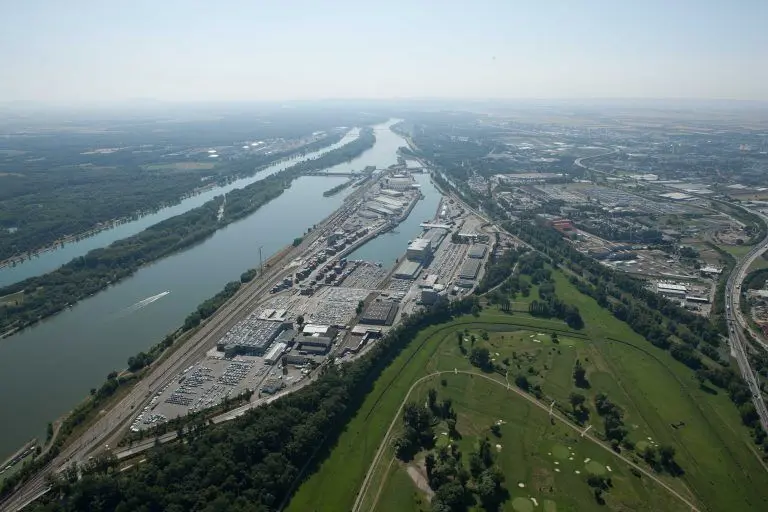Wiener Hafen – Success Story
Hafen Wien, a company of Wien Holding, operates three large ports including infrastructure: the Port of Freudenau, the Port of Albern as well as the Oil Port of Lobau. In all three ports around 1,000 cargo ships are handled each year. Via the waterway, mainly petroleum products as well as road salt, building materials such as cement, sand or steel products, and agricultural products such as grain and artificial fertilizers are delivered. The passenger port at the Reichsbrücke and the Marina Wien also belong to the Wiener Hafen Group.
The Port of Vienna is a multifunctional logistics center that offers both decades of experience and state-of-the-art technologies. Due to its optimal connection to the transport modes ship/train/truck and its proximity to Vienna – Schwechat Airport, it functions as a powerful interface for international trade and transport routes.
In addition, Hafen Wien operates the largest public customs warehouse in Austria. For the storage and/or handling of customs and domestic goods, modern warehouses as well as trained, well-equipped personnel are available. Its own customs office ensures rapid clearance. Hafen Wien is certified according to: ISO 9001:2008 – port handling, car terminal, real estate, ISO 14001:2009 – storage + handling in the warehouse as well as the extensions including the crane hall and according to GMP+.
The starting situation
The starting signal was the management’s order to the sales department to record visit reports. Initially, this data was entered into an Access database and maintained and managed there. The system was then called “Customer Management – Sales”. This database was implemented but only used sporadically.
In order to increase usability and gain a 360-degree view of the customer, several CRM systems were evaluated. KINAMU was selected from three providers. The decision fell on KINAMU with the CRM standard software Sugar. Decisive were the good price-performance ratio, the fact that all required functionalities were already available, and that the product met expectations.
Project goals
The aim was to introduce a state-of-the-art contact management software for sales, as well as to build a contact database for the global management of customers and contact data. An essential requirement for the project was the integration with Outlook to make the work easier for sales and users. Appointments, meetings, and to-dos can thus be managed more easily. The contact data should be stored in such a way that the system’s versatile evaluation options can be used: KPIs, pipeline, sales opportunities. The data from the Access database should be transferred to the new system.

Aerial view of Hafen Wien (c) LBS Redl
At a glance
| Company: | Hafen Wien |
| Industry: | Trade & Storage |
| Employees: | 225 |
| Number of users: | 15 |
| Implementation time: | 3 months |
Project goals:
- Centralization of customer and prospect data
- Process improvement
- 360° Reporting
Highlights:
- Fast implementation of requirements
- Good and fast project support
- Good contact and exchange with KINAMU
- Visit reports
- Own quotation tool
- Own event tool
- Creation of reports – KPIs
Website: Hafen Wien
Project progress
The project was started in May 2010 and the go-live took place in several phases, which was an advantage in this project. Due to the modular structure of the project, the desired requirements could be implemented step by step. In the course of the project, it quickly became, from an originally sales-planned tool, a central contact management . Thus, requirements for a general contact management with special features were also set and additional attributes for companies and contacts were introduced:
- Classifications
- VIP status
- special segmentations
“ All our initial expectations were quickly met ,” emphasizes Herr Lutz, IT Manager at Hafen Wien. “Project-accompanying and port-specific extensions could always be implemented quickly. ”
Frau Kunze, SugarCRM user from sales, believes: “The structure is good and you can quickly find your way around. The implemented modules are well thought out. You can work quickly with it. Capturing and entering contacts is super easy: fill in the fields and press save. Reports help with the work and offer additional functionality. These statistics are very important for our work.”
According to Herr Lutz, SugarCRM is a “well thought-out system with relatively simple customization and evaluation options” and Herr Lutz makes all users responsible: “The system must be lived, otherwise in two weeks you no longer know how it works and what’s in it.”
When asked what vision Herr Lutz has and what role Sugar should play in the organization, Mr. Lutz sees the following advantages and possibilities: “One of the main advantages is seamless business initiation. Customers are acquired centrally and through cross-divisional customer support, strategic and economic goals can be better achieved:
- Relief of operational units in sales
- Exploitation of cross-selling opportunities
- Increase in capacity utilization and sales efficiency
- Proactive customer approach (customer satisfaction)
- Sales data can be displayed from the ERP system.
- In the area of marketing, Herr Lutz sees potential: “By bundling and simplifying certain marketing processes, costs and time can be saved here.”
What advice does Herr Lutz have for other companies with similar challenges?
“It is important to have the involvement of all areas. The use of a person responsible for decisions. A clear definition of roles – who is responsible for what? What areas are there? Which processes should be mapped? And the definition of the individual characteristics within the customer management system. The best basis for this is a detailed and thoroughly tested requirements specification, which is created in collaboration with the departments.
The next step should be to discuss processes and procedures with the provider . Here the first important inputs come from both sides. You can use the mutual know-how and check what is needed and what is possible. Only then can you implement the system efficiently and cost-effectively without blocking options for the future.
It is important to see the service provider as a partner, because they have deep insight into the solution. You must always be careful to ensure that what was actually meant is also understood. That’s why it is also important to create a joint specifications document.
For the users , important basic guidelines should already be created during the introduction to give them a guide on how to use the system correctly. One of the most important points is the use of a person responsible for the project who is also involved with customer management. Because such a system must be lived.
According to Frau Buchecker, Head of Sales at Hafen Wien, she sees the potential in the coming years in ensuring that everyone works with the system. This way, these potentials can be used effectively. Data from, for example,
the real estate department is combined with sales and transshipment data, but also from marketing. Through this 360-degree view, all stakeholders gain a better understanding of the customer and their needs.

Harald Lutz – IT Manager Hafen Wien
“All our experiences were quickly fulfilled. Project-accompanying, port-specific extensions could always be implemented quickly.”

Frau Angela Kunze – Sales Employee
“The structure is good and you can quickly find your way around. The implemented modules are well thought out. You can work quickly with it.”

Frau Andrea Buchecker – Head of Sales
“Potentials through the 360-degree view of the customer increase efficiency in CRM and enable up- and cross-selling potentials. That’s why all departments should be involved.”